wheel size PONTIAC GTO 2006 Owners Manual
[x] Cancel search | Manufacturer: PONTIAC, Model Year: 2006, Model line: GTO, Model: PONTIAC GTO 2006Pages: 326, PDF Size: 1.62 MB
Page 191 of 326
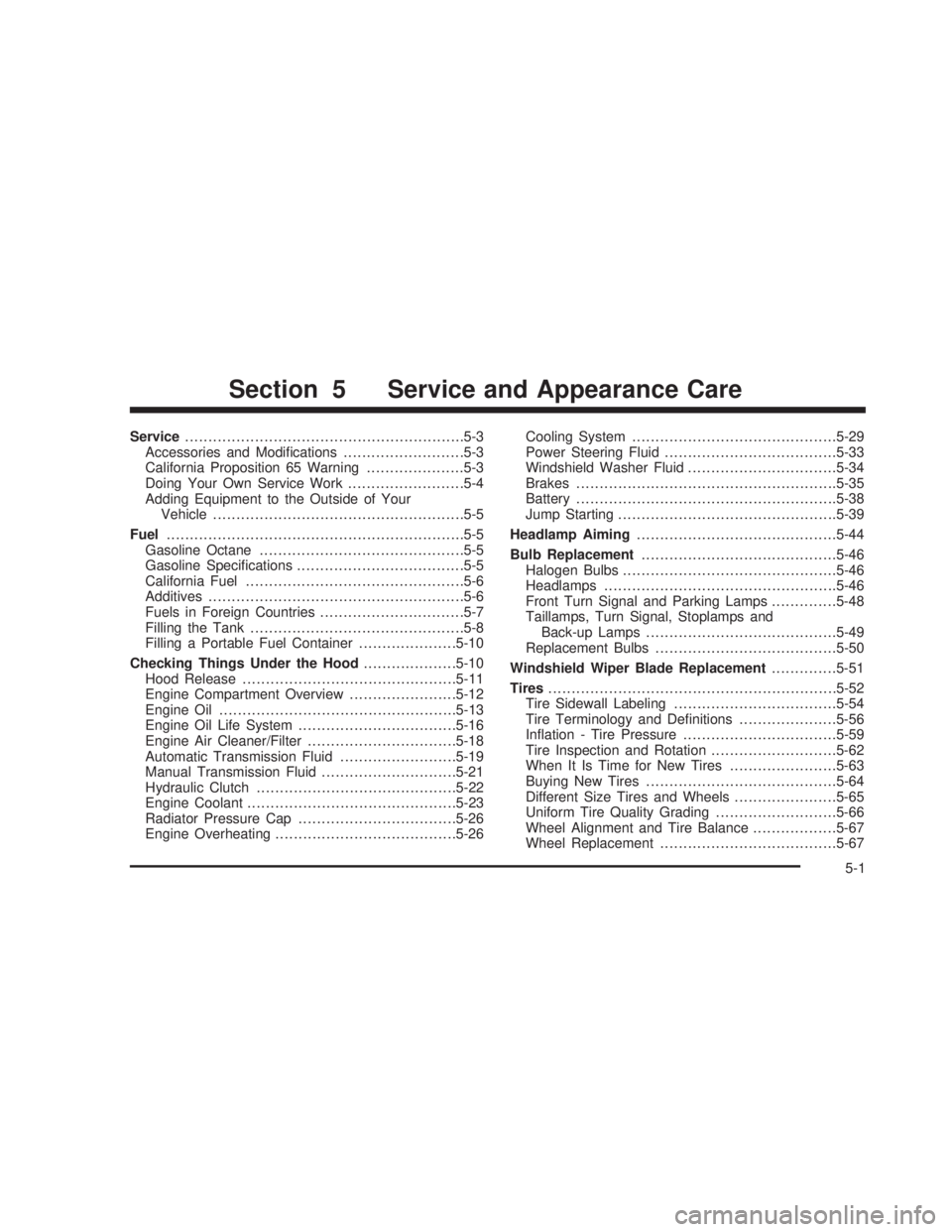
Service............................................................5-3
Accessories and Modi®cations..........................5-3
California Proposition 65 Warning.....................5-3
Doing Your Own Service Work.........................5-4
Adding Equipment to the Outside of Your
Vehicle......................................................5-5
Fuel................................................................5-5
Gasoline Octane............................................5-5
Gasoline Speci®cations....................................5-5
California Fuel...............................................5-6
Additives.......................................................5-6
Fuels in Foreign Countries...............................5-7
Filling the Tank..............................................5-8
Filling a Portable Fuel Container.....................5-10
Checking Things Under the Hood....................5-10
Hood Release..............................................5-11
Engine Compartment Overview.......................5-12
Engine Oil...................................................5-13
Engine Oil Life System..................................5-16
Engine Air Cleaner/Filter................................5-18
Automatic Transmission Fluid.........................5-19
Manual Transmission Fluid.............................5-21
Hydraulic Clutch...........................................5-22
Engine Coolant.............................................5-23
Radiator Pressure Cap..................................5-26
Engine Overheating.......................................5-26Cooling System............................................5-29
Power Steering Fluid.....................................5-33
Windshield Washer Fluid................................5-34
Brakes........................................................5-35
Battery........................................................5-38
Jump Starting...............................................5-39
Headlamp Aiming...........................................5-44
Bulb Replacement..........................................5-46
Halogen Bulbs..............................................5-46
Headlamps..................................................5-46
Front Turn Signal and Parking Lamps..............5-48
Taillamps, Turn Signal, Stoplamps and
Back-up Lamps.........................................5-49
Replacement Bulbs.......................................5-50
Windshield Wiper Blade Replacement..............5-51
Tires..............................................................5-52
Tire Sidewall Labeling...................................5-54
Tire Terminology and De®nitions.....................5-56
In¯ation - Tire Pressure.................................5-59
Tire Inspection and Rotation...........................5-62
When It Is Time for New Tires.......................5-63
Buying New Tires.........................................5-64
Different Size Tires and Wheels......................5-65
Uniform Tire Quality Grading..........................5-66
Wheel Alignment and Tire Balance..................5-67
Wheel Replacement......................................5-67
Section 5 Service and Appearance Care
5-1
2006 - Pontiac GTO Owner Manual
Page 242 of 326
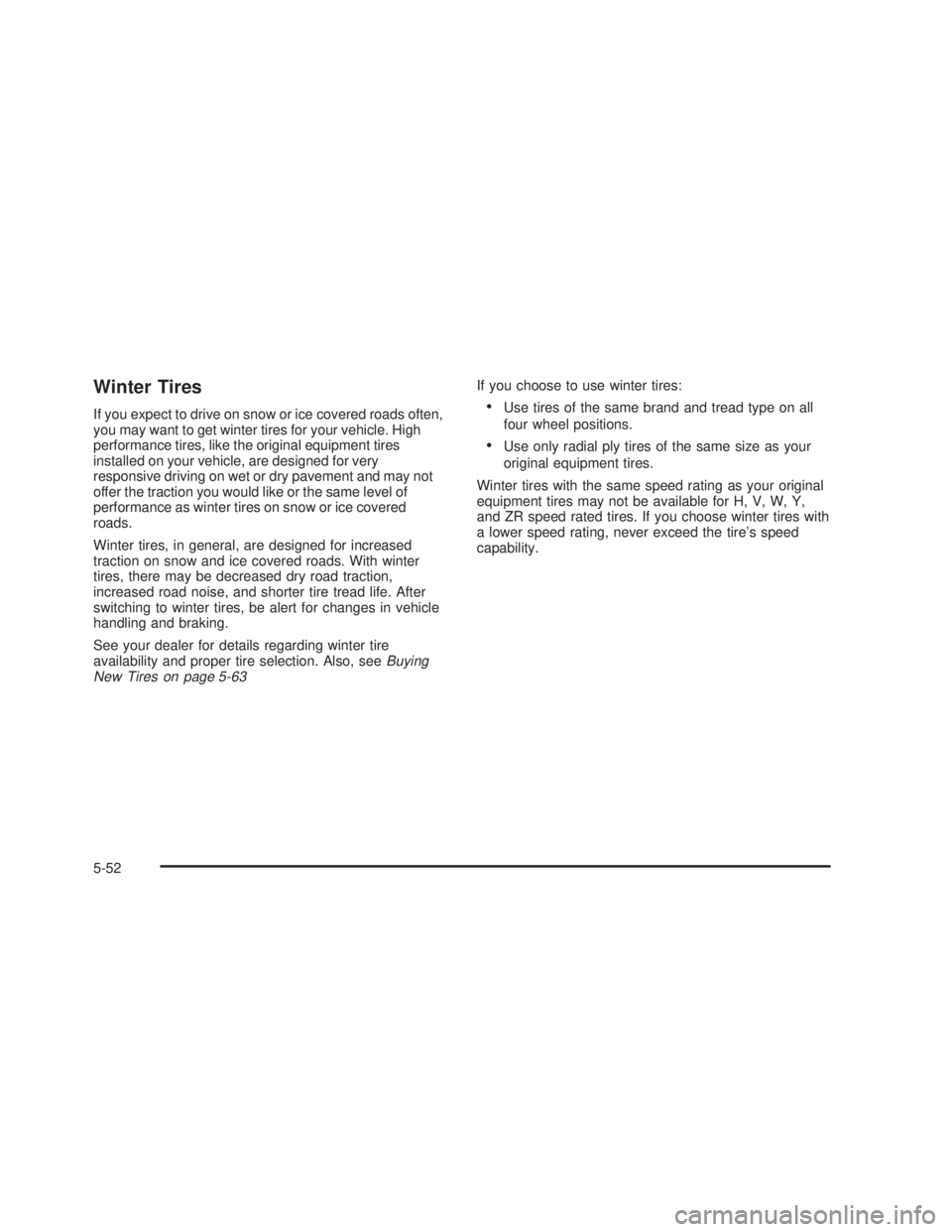
Winter Tires
If you expect to drive on snow or ice covered roads often,
you may want to get winter tires for your vehicle. High
performance tires, like the original equipment tires
installed on your vehicle, are designed for very
responsive driving on wet or dry pavement and may not
offer the traction you would like or the same level of
performance as winter tires on snow or ice covered
roads.
Winter tires, in general, are designed for increased
traction on snow and ice covered roads. With winter
tires, there may be decreased dry road traction,
increased road noise, and shorter tire tread life. After
switching to winter tires, be alert for changes in vehicle
handling and braking.
See your dealer for details regarding winter tire
availability and proper tire selection. Also, see
Buying
New Tires on page 5-63
If you choose to use winter tires:
·Use tires of the same brand and tread type on all
four wheel positions.
·Use only radial ply tires of the same size as your
original equipment tires.
Winter tires with the same speed rating as your original
equipment tires may not be available for H, V, W, Y,
and ZR speed rated tires. If you choose winter tires with
a lower speed rating, never exceed the tire's speed
capability.
5-52
2006 - Pontiac GTO Owner Manual
Page 245 of 326

Tire Size
The following illustration shows an example of a typical
passenger vehicle tire size.
(A) Passenger (P-Metric) Tire:The United States
version of a metric tire sizing system. The letter P as the
®rst character in the tire size means a passenger
vehicle tire engineered to standards set by the U.S. Tire
and Rim Association.
(B) Tire Width:The three-digit number indicates the
tire section width in millimeters from sidewall to sidewall.
(C) Aspect Ratio:A two-digit number that indicates
the tire height-to-width measurements. For example, if
the tire size aspect ratio is 60, as shown in item C of the
illustration, it would mean that the tire's sidewall is
60 percent as high as it is wide.
(D) Construction Code:A letter code is used to
indicate the type of ply construction in the tire. The
letter R means radial ply construction; the letter D means
diagonal or bias ply construction; and the letter B means
belted-bias ply construction.(E) Rim Diameter:Diameter of the wheel in inches.
(F) Service Description:These characters represent
the load range and speed rating of the tire. The load
index represents the load carry capacity a tire is certi®ed
to carry. The load index can range from 1 to 279. The
speed rating is the maximum speed a tire is certi®ed
to carry a load. Speed ratings range from A to Z.
Tire Terminology and De®nitions
Air Pressure:The amount of air inside the tire pressing
outward on each square inch of the tire. Air pressure
is expressed in pounds per square inch (psi) or
kilopascal (kPa).
Accessory Weight:This means the combined weight
of optional accessories. Some examples of optional
accessories are, automatic transmission, power steering,
power brakes, power windows, power seats, and air
conditioning.
Aspect Ratio:The relationship of a tire's height to its
width.
Belt:A rubber coated layer of cords that is located
between the plies and the tread. Cords may be made
from steel or other reinforcing materials.
Bead:The tire bead contains steel wires wrapped by
steel cords that hold the tire onto the rim.
5-55
2006 - Pontiac GTO Owner Manual
Page 252 of 326

After the tires have been rotated, adjust the front and
rear in¯ation pressures as shown on the Tire and
Loading Information label. Make certain that all wheel
nuts are properly tightened. See ªWheel Nut Torqueº
under
Capacities and Speci®cations on page 5-90.
{CAUTION:
Rust or dirt on a wheel, or on the parts to
which it is fastened, can make wheel nuts
become loose after a time. The wheel could
come off and cause an accident. When you
change a wheel, remove any rust or dirt from
places where the wheel attaches to the vehicle.
In an emergency, you can use a cloth or a
paper towel to do this; but be sure to use a
scraper or wire brush later, if needed, to get all
the rust or dirt off. See
Changing a Flat Tire on
page 5-69
.
When It Is Time for New Tires
One way to tell when it is
time for new tires is to
check the treadwear
indicators, which will
appear when your tires
have only 1/16 inch
(1.6 mm) or less of tread
remaining.
You need a new tire if any of the following statements
are true:
·You can see the indicators at three or more places
around the tire.
·You can see cord or fabric showing through the
tire's rubber.
·The tread or sidewall is cracked, cut, or snagged
deep enough to show cord or fabric.
·The tire has a bump, bulge, or split.
·The tire has a puncture, cut or other damage that
cannot be repaired well because of the size or
location of the damage.
5-62
2006 - Pontiac GTO Owner Manual
Page 253 of 326
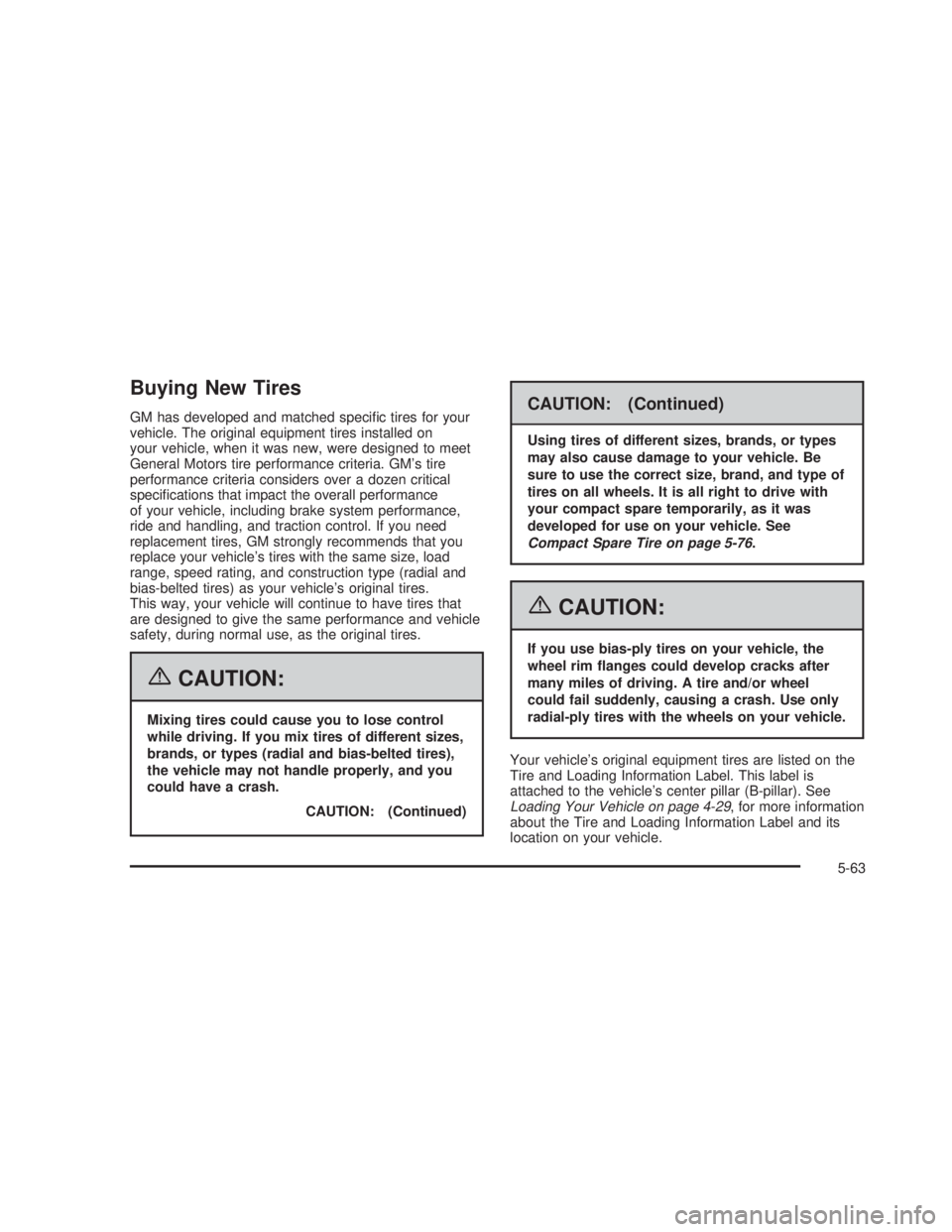
Buying New Tires
GM has developed and matched speci®c tires for your
vehicle. The original equipment tires installed on
your vehicle, when it was new, were designed to meet
General Motors tire performance criteria. GM's tire
performance criteria considers over a dozen critical
speci®cations that impact the overall performance
of your vehicle, including brake system performance,
ride and handling, and traction control. If you need
replacement tires, GM strongly recommends that you
replace your vehicle's tires with the same size, load
range, speed rating, and construction type (radial and
bias-belted tires) as your vehicle's original tires.
This way, your vehicle will continue to have tires that
are designed to give the same performance and vehicle
safety, during normal use, as the original tires.
{CAUTION:
Mixing tires could cause you to lose control
while driving. If you mix tires of different sizes,
brands, or types (radial and bias-belted tires),
the vehicle may not handle properly, and you
could have a crash.
CAUTION: (Continued)
CAUTION: (Continued)
Using tires of different sizes, brands, or types
may also cause damage to your vehicle. Be
sure to use the correct size, brand, and type of
tires on all wheels. It is all right to drive with
your compact spare temporarily, as it was
developed for use on your vehicle. See
Compact Spare Tire on page 5-76.
{CAUTION:
If you use bias-ply tires on your vehicle, the
wheel rim ¯anges could develop cracks after
many miles of driving. A tire and/or wheel
could fail suddenly, causing a crash. Use only
radial-ply tires with the wheels on your vehicle.
Your vehicle's original equipment tires are listed on the
Tire and Loading Information Label. This label is
attached to the vehicle's center pillar (B-pillar). See
Loading Your Vehicle on page 4-29, for more information
about the Tire and Loading Information Label and its
location on your vehicle.
5-63
2006 - Pontiac GTO Owner Manual
Page 254 of 326

Different Size Tires and Wheels
If you add wheels or tires that are a different size than
your original equipment wheels and tires, this may
affect the way your vehicle performs, including its
braking, ride and handling characteristics, stability and
resistance to rollover. Additionally, if your vehicle
has electronic systems such as, anti-lock brakes,
traction control, and electronic stability control, the
performance of these systems can be affected.
{CAUTION:
If you add different sized wheels, your vehicle
may not provide an acceptable level of
performance and safety if tires not
recommended for those wheels are selected.
You may increase the chance that you will
crash and suffer serious injury. Only use GM
speci®c wheel and tire systems developed for
your vehicle, and have them properly installed
by a GM certi®ed technician.
See
Buying New Tires on page 5-63andAccessories
and Modi®cations on page 5-3for additional information.
Uniform Tire Quality Grading
Quality grades can be found where applicable on the
tire sidewall between tread shoulder and maximum
section width. For example:
Treadwear 200 Traction AA Temperature A
The following information relates to the system
developed by the United States National Highway
Traffic Safety Administration (NHTSA), which grades
tires by treadwear, traction, and temperature
performance. This applies only to vehicles sold in the
United States. The grades are molded on the sidewalls
of most passenger car tires. The Uniform Tire Quality
Grading (UTQG) system does not apply to deep
tread, winter-type snow tires, space-saver, or temporary
use spare tires, tires with nominal rim diameters of
10 to 12 inches (25 to 30 cm), or to some
limited-production tires.
While the tires available on General Motors passenger
cars and light trucks may vary with respect to these
grades, they must also conform to federal safety
requirements and additional General Motors Tire
Performance Criteria (TPC) standards.
5-64
2006 - Pontiac GTO Owner Manual
Page 257 of 326
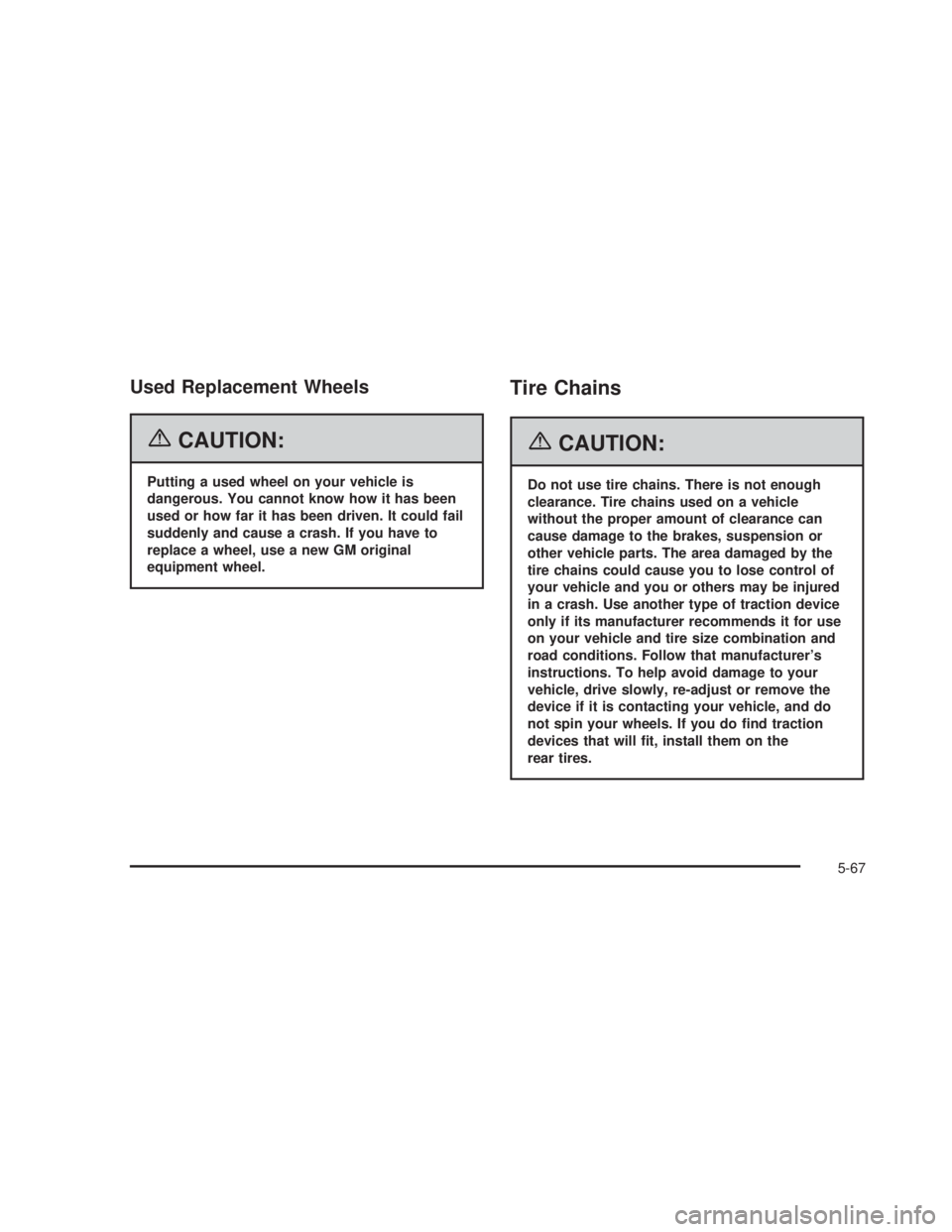
Used Replacement Wheels
{CAUTION:
Putting a used wheel on your vehicle is
dangerous. You cannot know how it has been
used or how far it has been driven. It could fail
suddenly and cause a crash. If you have to
replace a wheel, use a new GM original
equipment wheel.
Tire Chains
{CAUTION:
Do not use tire chains. There is not enough
clearance. Tire chains used on a vehicle
without the proper amount of clearance can
cause damage to the brakes, suspension or
other vehicle parts. The area damaged by the
tire chains could cause you to lose control of
your vehicle and you or others may be injured
in a crash. Use another type of traction device
only if its manufacturer recommends it for use
on your vehicle and tire size combination and
road conditions. Follow that manufacturer's
instructions. To help avoid damage to your
vehicle, drive slowly, re-adjust or remove the
device if it is contacting your vehicle, and do
not spin your wheels. If you do ®nd traction
devices that will ®t, install them on the
rear tires.
5-67
2006 - Pontiac GTO Owner Manual
Page 265 of 326
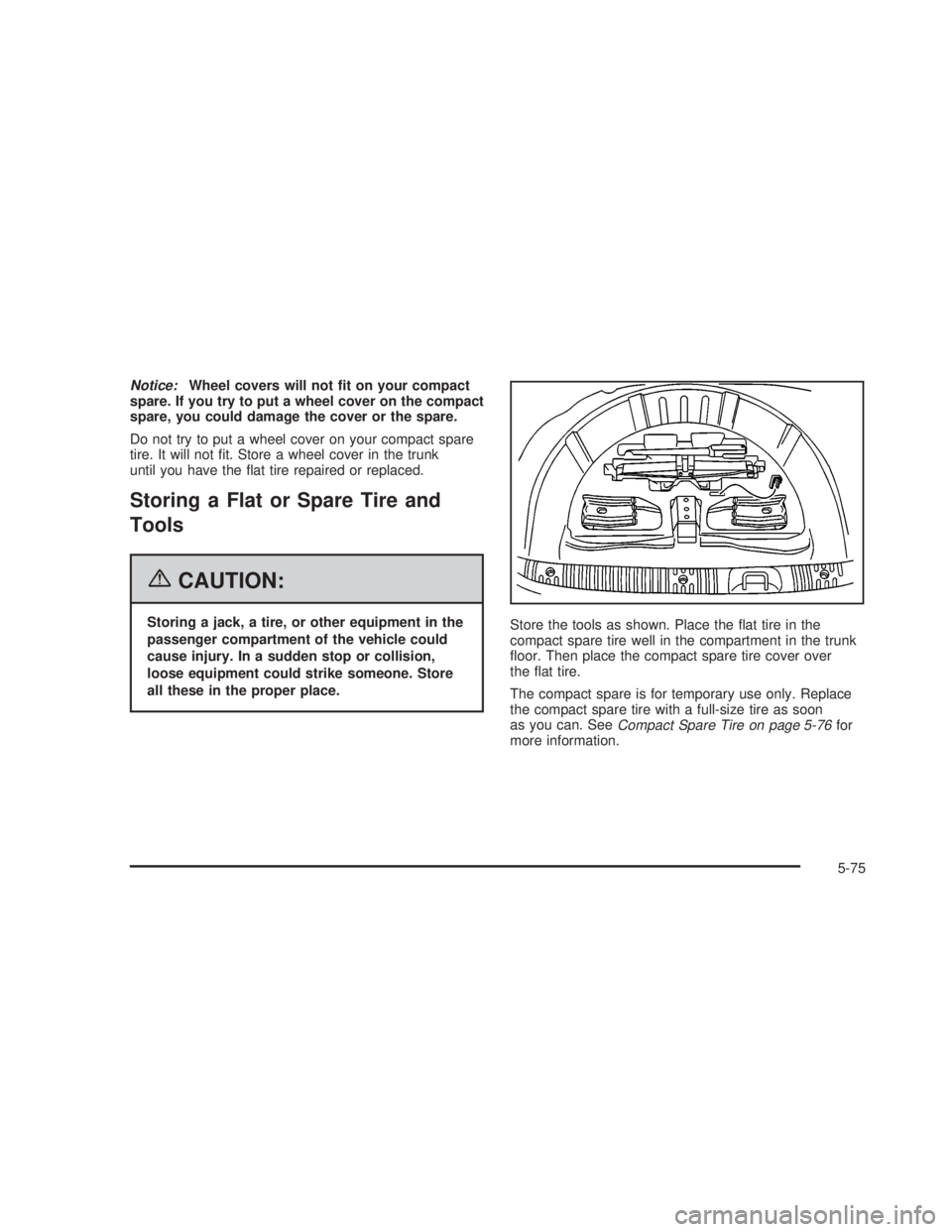
Notice:Wheel covers will not ®t on your compact
spare. If you try to put a wheel cover on the compact
spare, you could damage the cover or the spare.
Do not try to put a wheel cover on your compact spare
tire. It will not ®t. Store a wheel cover in the trunk
until you have the ¯at tire repaired or replaced.
Storing a Flat or Spare Tire and
Tools
{CAUTION:
Storing a jack, a tire, or other equipment in the
passenger compartment of the vehicle could
cause injury. In a sudden stop or collision,
loose equipment could strike someone. Store
all these in the proper place.Store the tools as shown. Place the ¯at tire in the
compact spare tire well in the compartment in the trunk
¯oor. Then place the compact spare tire cover over
the ¯at tire.
The compact spare is for temporary use only. Replace
the compact spare tire with a full-size tire as soon
as you can. See
Compact Spare Tire on page 5-76for
more information.
5-75
2006 - Pontiac GTO Owner Manual
Page 266 of 326
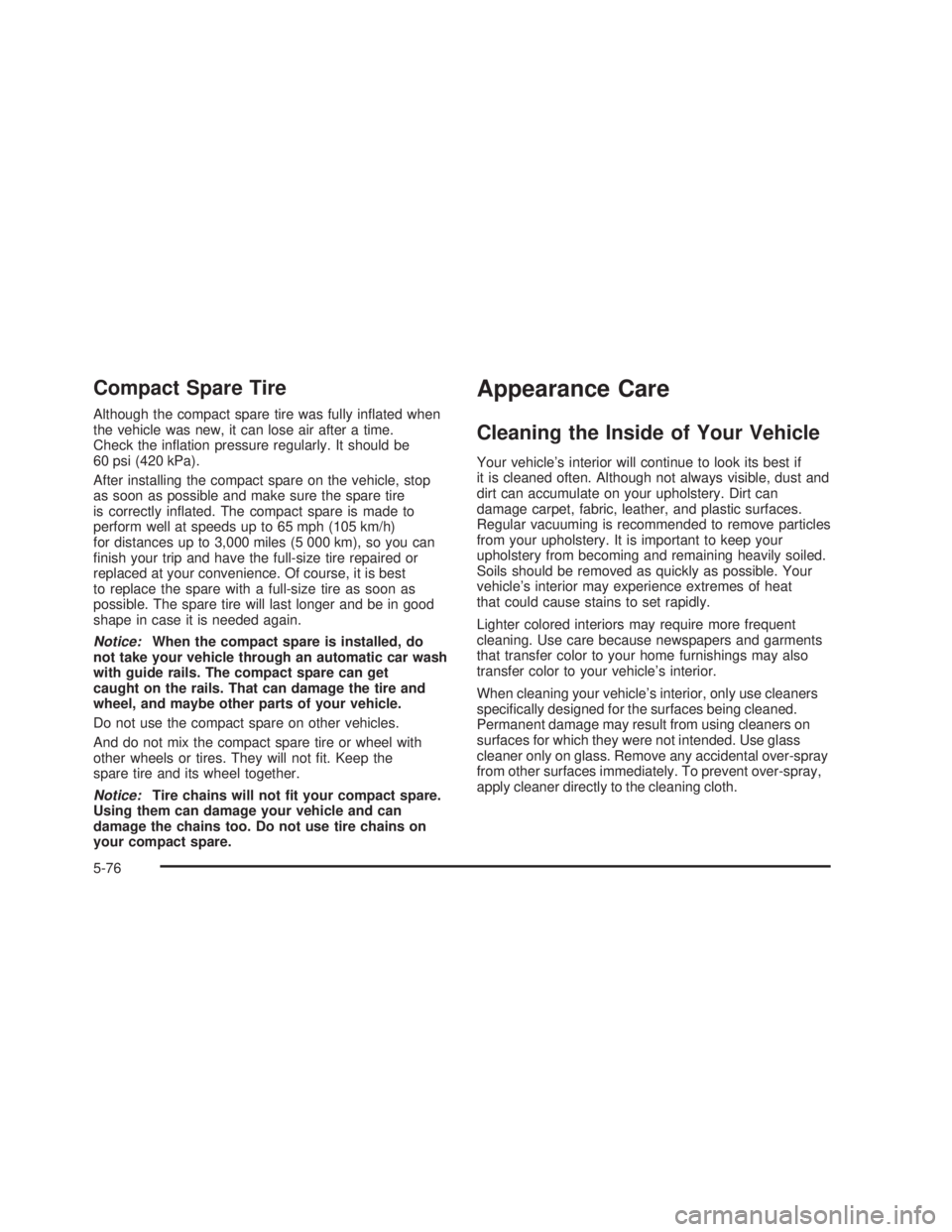
Compact Spare Tire
Although the compact spare tire was fully in¯ated when
the vehicle was new, it can lose air after a time.
Check the in¯ation pressure regularly. It should be
60 psi (420 kPa).
After installing the compact spare on the vehicle, stop
as soon as possible and make sure the spare tire
is correctly in¯ated. The compact spare is made to
perform well at speeds up to 65 mph (105 km/h)
for distances up to 3,000 miles (5 000 km), so you can
®nish your trip and have the full-size tire repaired or
replaced at your convenience. Of course, it is best
to replace the spare with a full-size tire as soon as
possible. The spare tire will last longer and be in good
shape in case it is needed again.
Notice:When the compact spare is installed, do
not take your vehicle through an automatic car wash
with guide rails. The compact spare can get
caught on the rails. That can damage the tire and
wheel, and maybe other parts of your vehicle.
Do not use the compact spare on other vehicles.
And do not mix the compact spare tire or wheel with
other wheels or tires. They will not ®t. Keep the
spare tire and its wheel together.
Notice:Tire chains will not ®t your compact spare.
Using them can damage your vehicle and can
damage the chains too. Do not use tire chains on
your compact spare.
Appearance Care
Cleaning the Inside of Your Vehicle
Your vehicle's interior will continue to look its best if
it is cleaned often. Although not always visible, dust and
dirt can accumulate on your upholstery. Dirt can
damage carpet, fabric, leather, and plastic surfaces.
Regular vacuuming is recommended to remove particles
from your upholstery. It is important to keep your
upholstery from becoming and remaining heavily soiled.
Soils should be removed as quickly as possible. Your
vehicle's interior may experience extremes of heat
that could cause stains to set rapidly.
Lighter colored interiors may require more frequent
cleaning. Use care because newspapers and garments
that transfer color to your home furnishings may also
transfer color to your vehicle's interior.
When cleaning your vehicle's interior, only use cleaners
speci®cally designed for the surfaces being cleaned.
Permanent damage may result from using cleaners on
surfaces for which they were not intended. Use glass
cleaner only on glass. Remove any accidental over-spray
from other surfaces immediately. To prevent over-spray,
apply cleaner directly to the cleaning cloth.
5-76
2006 - Pontiac GTO Owner Manual
Page 325 of 326

T
Tachometer....................................................3-24
Taillamps
Turn Signal, Stoplamps and Back-up Lamps....5-48
Theft-Deterrent, Radio.....................................3-55
Theft-Deterrent Systems...................................2-14
Content Theft-Deterrent................................2-15
Immobilizer.................................................2-14
Immobilizer Operation...................................2-14
Tilt Wheel........................................................ 3-6
Tires.............................................................5-51
Aluminum Wheels, Cleaning..........................5-81
Buying New Tires........................................5-63
Chains.......................................................5-67
Changing a Flat Tire....................................5-69
Cleaning....................................................5-82
Compact Spare Tire.....................................5-76
Different Size..............................................5-64
If a Tire Goes Flat.......................................5-68
In¯ation - Tire Pressure................................5-58
Inspection and Rotation................................5-61
Installing the Spare Tire................................5-71
Removing the Flat Tire.................................5-71
Removing the Spare Tire and Tools...............5-70Tires (cont.)
Storing a Flat or Spare Tire and Tools............5-75
Tire Sidewall Labeling..................................5-53
Tire Terminology and De®nitions....................5-55
Uniform Tire Quality Grading.........................5-64
Wheel Alignment and Tire Balance.................5-66
Wheel Replacement.....................................5-66
When It Is Time for New Tires......................5-62
Towing
Recreational Vehicle.....................................4-34
Towing a Trailer..........................................4-34
Your Vehicle...............................................4-34
Traction
Control System (TCS).................................... 4-9
Transmission
Fluid, Automatic...........................................5-19
Fluid, Manual..............................................5-21
One-to-Four Shift Light.................................3-26
Transmission Operation, Automatic....................2-19
Transmission Operation, Manual........................2-21
Trip Computer................................................3-33
Trunk.............................................................. 2-9
Trunk Lamps..................................................3-16
Turn and Lane-Change Signals.......................... 3-8
Turn Signal/Multifunction Lever........................... 3-7
11
2006 - Pontiac GTO Owner Manual